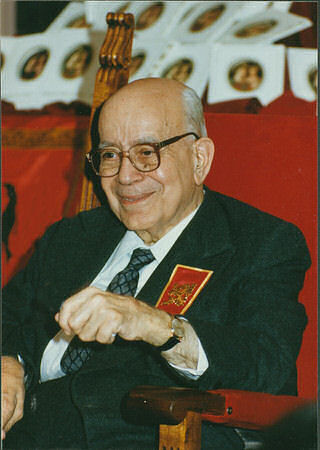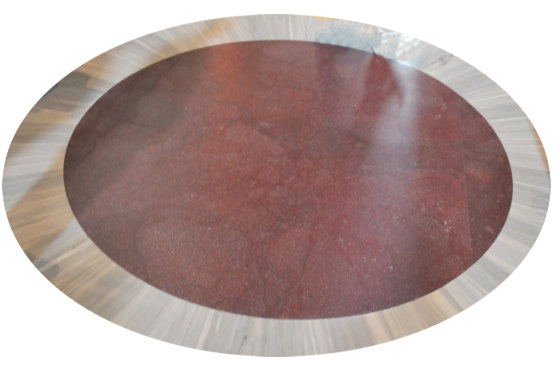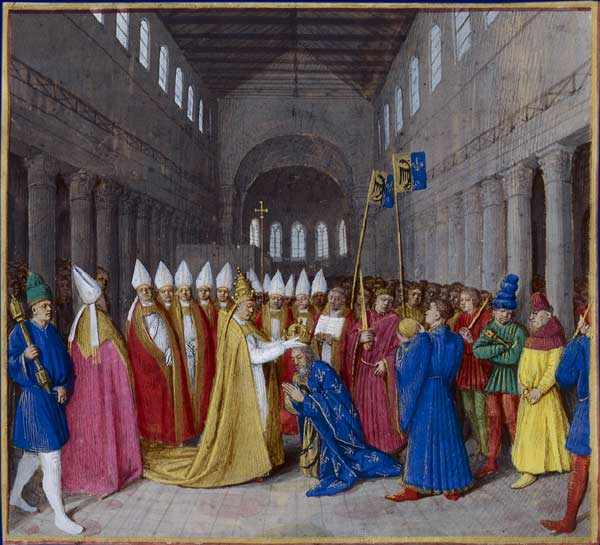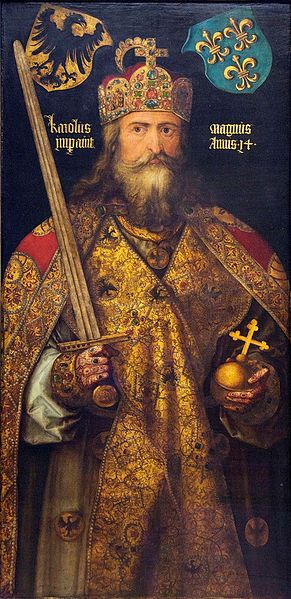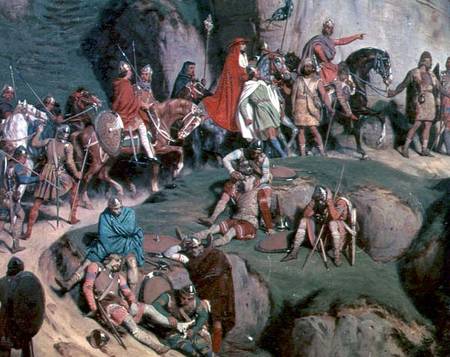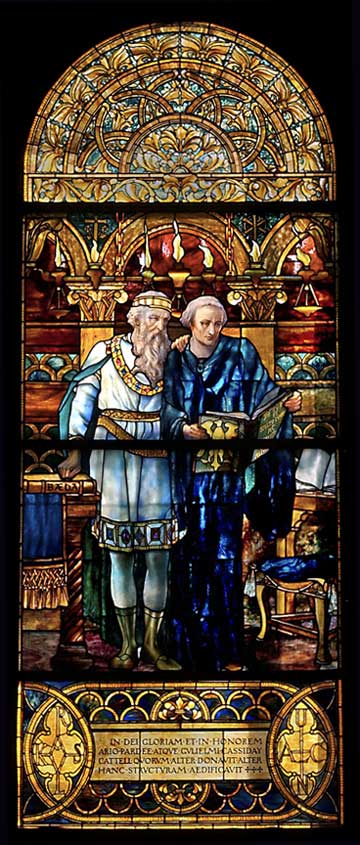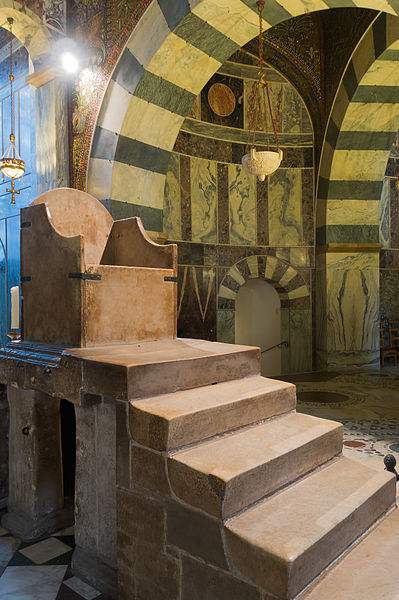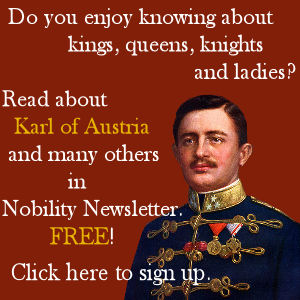Plinio Corrêa de Oliveira, Saint of the Day, October 30, 1972
Here is an excerpt on Charlemagne taken from the renowned historian, J.B. Weiss’ História Universal:
“In 772, at the age of 30, Charles took over the government of the Kingdom of the Franks. He was rightly called Charles the Great, a name he deserved as a general and conqueror, organizer and legislator of his vast empire, and as the driving force of spiritual life throughout the West.
“Under his governance, Christian ideas achieved victories over the barbarians. His life was a constant struggle against the rudeness and barbarism that threatened the Catholic religion and the new culture then emerging.
“He undertook no fewer than 53 military expeditions, eighteen against the Saxons, one against Aquitaine, five against the Lombards, seven against the Arabs of Spain, one against the Thuringeans, four against the Avars, two against the Britons, one against the Bavarians, four against the Slavs, five against the Saracens of Italy, three against the Danes, and two against the Greeks.
“At Christmas in the year 800, Pope St. Leo III elevated him to the dignity of Emperor thus founding the Holy Roman German Empire, the noblest temporal institution of Christendom. Charles died on 29 February 814, after receiving Holy Communion. According to legend, he was buried in a niche at the cathedral of Aix-la-Chapelle sitting upright on a throne, girt with his sword, and holding he book of the Gospels in his hands.
“He is the model of Catholic emperors, the prototype of the knight, and the central figure of most chansons de geste of the Middle Ages.”
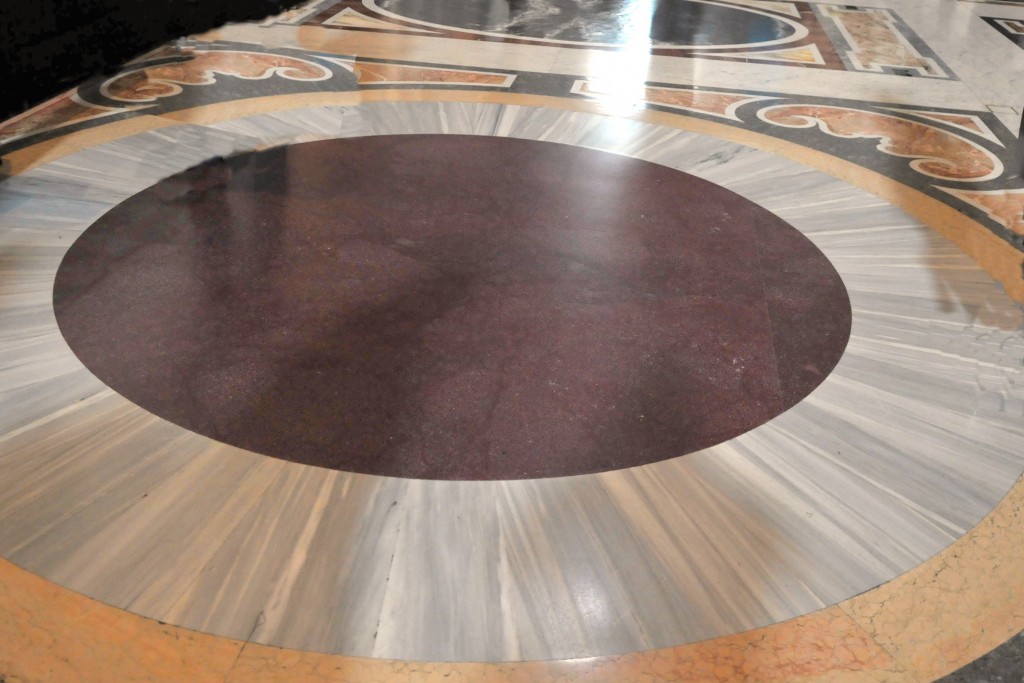
At St. Peter’s Basilica in Rome, a few steps after entering the central nave, one admire the famous “porphyretic circle,” a great disc of porphyry—a superb, wine-colored marble. Upon it, Charlemagne was sacred Emperor by Pope Leo III at Christmas of the year 800.
I don’t know why, speaking about Charlemagne and his deeds and greatness, also brings to mind the extraordinary figure of Moses, with his own deeds and his greatness. Moses established order among the chosen people, who were a pre-figure of Christendom. He was the one who received the revelation of the Ten Commandments of the Law, led the chosen people to the gates of the Promised Land, took them out of captivity and thus established the basic elements for them to settle down and for the Savior to be born from them.
Charlemagne’s task was essentially similar to that of Moses. He took the Catholic people, subject to impending bondage by their worst opponents, and through a tremendous fight defeated them all and laid the foundations of Christian civilization.
For us to an idea of what Charlemagne’s task was like, we must consider the conditions of his time.
As you know, the Western Roman Empire covered all of Western Europe until the fifth century of our era. And in very general terms its borders extended from the Rhine and the Danube all the way to Portugal, in the west; to England, in the north and to Italy, in the south. Therefore, it was an immense unit made even more immense because at that time the lines of communication were much slower, making it difficult for an emperor to govern that whole expanse. Accordingly, calculated in relation to the administrative and political machine needed to maintain the unity of such an empire, its dimensions were gigantic.
This empire was overthrown by the avalanche of barbarians. As you know, the latter were Aryans or pagans. Aryanism was a heresy which can be loosely compared to Protestantism. The Aryan was as anti-Catholic as a Protestant. An Arian bishop called Ulfilas had perverted pagan barbarians to the Aryan religion so that most of the barbarians who invaded the (Catholic) Roman Empire were Aryans who came with the intention of imposing their religion. Others were pagans who wanted to impose paganism. Both were barbarians, and as such they were incompatible with civilization by habit, psychology, and natural tendency. They settled in the Western Roman Empire and gradually, willingly or not, tore civilization to bits.
For you to have an idea of how these invaders were really barbarian, suffice it to say that in general they did not understand that one could sleep indoors, because they felt claustrophobic. So they would sleep in public squares. There was a barbarian tribe that felt claustrophobic even if sleeping in town, so when night came they would open the city gate and go to sleep in the bush as they had difficulty breathing in the city. No comment…
A very serious problem the barbarians faced was whether it was worthwhile for them to become literate. Indeed, they saw that the Romans were literate but were also very decadent, corrupt, and bad soldiers, and the Barbarians thought the reason for that was their literacy. So they had the greatest contempt for a man who learned how to read and write. A literate person was thought to be effeminate. So you see how messed up their ideas were.
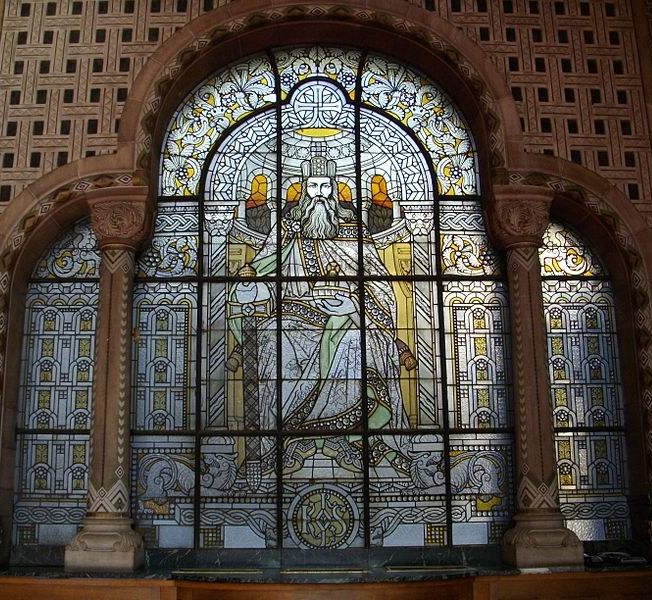
Stained-glass of Charlemagne sitting on his throne in the railway station of Metz, representing the imperial protection over Metz during the German annexation of the city. Photo by Fab5669.
When the barbarians began to settle on European soil and impose their tyranny, it turned out that that the Church was the only thing still standing amid the ruins of the Empire. The Western Roman Empire disappeared, but the Church remained standing with heir dioceses, convents etc.
So the way of salvation to try and get out of the abyss was to strengthen the influence of the Church and thereby lift Europe out the miserable situation in which it had fallen.
In the meantime, another disaster occurs. Because of the softness and “fifth-column” mentality of the Ostrogoths who inhabited Spain, the Iberian Peninsula is invaded by Muslims. It was almost entirely taken and Arab waves began to invade semi-Roman and semi-barbaric Europe across the Pyrenees.
Muslims would get on boats, land in Italy and in southern France and began invading them too. So the open wound which was Europe at that time also began to suffer the Mohammedan onslaught.
It was then, when all seemed lost, that God raised this extraordinary man who was Charlemagne; a man who –in my opinion — was a prophet. In other words, a man who realized the kingdom of God because he had the gifts of understanding in what that kingdom consisted, and leading others to join in his resolve to achieve that work. Moreover, he had to overcome the obstacles opposed to that realization.
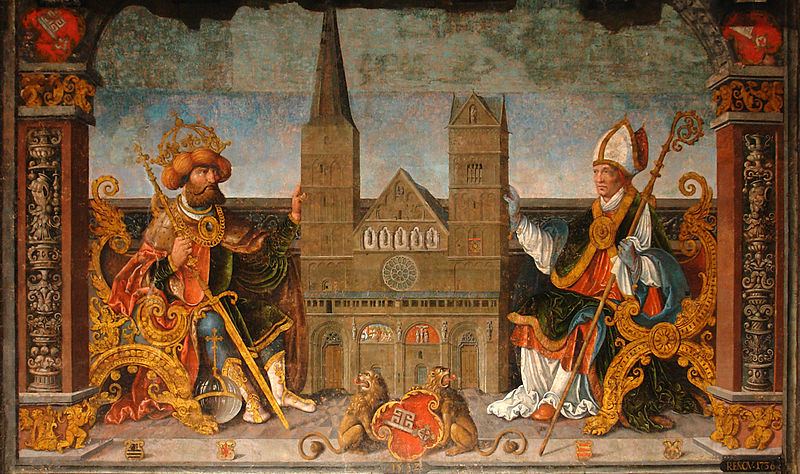
Fresco in the Townhall in Bremen, symbolically showing the creation and transferring of the diocese of Bremen, to Bishop of Bremen, St. Willehad by the Emperor Charlemagne. The diocese, a model of the Bremen Cathedral, in its form of 1532, is located between the two. Photo by Godewind
Charlemagne came from a family that had reigned upon the Franks for two generations. While also divided by internecine wars and struggles, that family was influential among the Franks – only one of the barbarian peoples that existed in Europe.
While leading the Franks, Charlemagne waged a series of wars as you have seen above, many military expeditions in which he completely defeated the barbarians. And later he also contained the Mohammedan power and thus pushed back the gates of history. In fact, history seemed to have irrevocably condemned the Latin peoples to disappear under Germanic and Mohammedan pressure. Charlemagne saved the Latin civilization; and by saving latinitas, he saved Christendom.
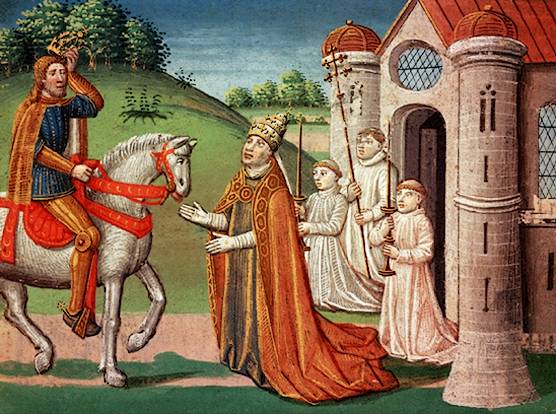
Charlemagne meets Pope Adrian I in the outskirts of Rome. The pontiff asks him to help Holy Church, besieged by enemies.
According to available descriptions, the man who carried out such extraordinary deeds was Herculean. Tall, with very regular features and very well built, he kept something of his youth even in old age, and in his youth days had something of the maturity of old age; when young he instilled respect as if he were an old man. And in his old age, he infused enthusiasm in others like a boy.
He was a man so kind and gentle that the popular legend said flowers would bloom throughout his white beard when he smiled, and his beard was in full bloom. He was called “the king of the flourishing beard.” This gives an idea of how rich a personality he was: terrible in combat – when his opponents learned that Charlemagne was at the battle front, they had already lost half the battle — yet so kind and gentle that people imagined flowers springing from beard.
This great warrior was at the same time a great mentor. He formed a handful of men who became known in history as the Twelve Peers of Charlemagne. The expression, “Peer of Charlemagne,” denotes an ideal relationship. Never before in the temporal order had a relationship between a leader and his subjects been so noble, elevated and strong; never the condition of subject had been so categorical but at the same time communicated such greatness as that of being a Peer of Charlemagne.
There was such a difference between Charlemagne and his peers that all of them together did not make one Charlemagne. Yet, a Peer of Charlemagne reflected an aspect of his personality to such an extent that he was like his son and ambassador, bringing all that charlemagnicity and participating in his majesty, strength and greatness . . . Although he was unmistakable, his Peers became, as it were, other Charlemagnes.
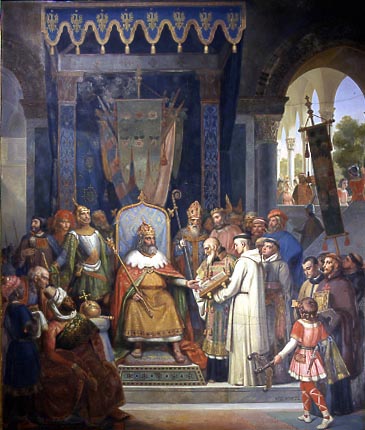
Emperor Charlemagne surrounded by his officers receiving Alcuin, who is presenting manuscripts made by his Monks Painted by Victor Schnetz
In this relationship is found precisely the beauty of the bond that held them together. On the other hand, a very beautiful aspect to be considered was the solidarity of these Peers: a solidarity without pride or envy, which sought exclusively to serve the Emperor and consequently the cause of Christian Civilization and therefore the Catholic Church… Our Lady … and Our Lord Jesus Christ in the highest heaven! For this end they were closely united among themselves. The Peers of Charlemagne were united by the ideal model of a noble, strong, manly, unpretentious, and loyal friendship.
This is the reason why Christian tradition in many countries of Europe gave the nobility the title of peer: “Peer of the Realm” in the UK; “Peer of the Realm” in France … It was a copy of the relationship between Charlemagne and his Peers, which so personified the perfect relationship with subjects, raising them to the condition of sons and ‘my other selves’ while still clearly keeping them in the position of subjects.
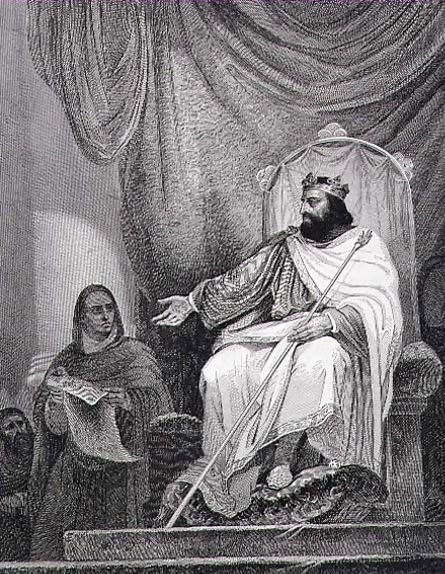 This man of fiery piety was also illiterate… An illiteracy which shows us how very little it is to merely learn to read and write. Many of those who learn to read and write have the misguided idea that thinking begins with the book. According to this notion, when a person decides to think about something the first step is for him to buy a book and read something about the subject in order to think about what he reads.
This man of fiery piety was also illiterate… An illiteracy which shows us how very little it is to merely learn to read and write. Many of those who learn to read and write have the misguided idea that thinking begins with the book. According to this notion, when a person decides to think about something the first step is for him to buy a book and read something about the subject in order to think about what he reads.
But Charlemagne, who could neither read nor write, knew how to grasp things from another angle. He had such a sense of things and such intelligence that he organized education throughout his Empire by calling men like Alcuin, who served him as a kind of “Minister of Culture.”
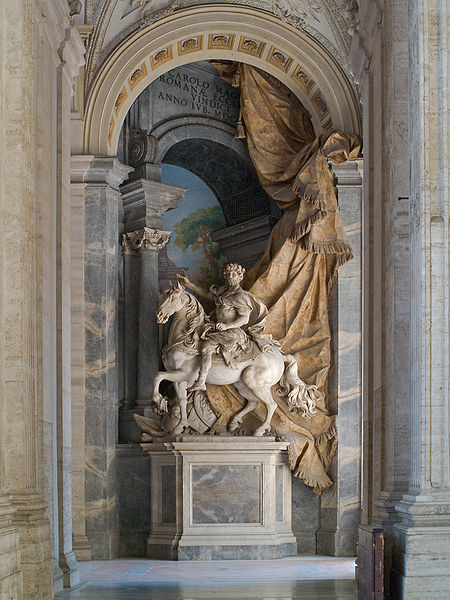
Monumental equestrian statue of Charlemagne, by Agostino Cornacchini (1725) — St. Peter’s Basilica, Vatican. Photo by Myrabella.
There is more. He was present at bishops’ councils and watched them decide, as they are the ones who must decide about Church affairs. Nevertheless, Charlemagne took the floor and delved into the theological debates being held, usually successfully. He was the one who had the right theological formula even though he never went to a seminary. You can see what he was like!
This son of the Church was her rampart, support, and glory. He did not infringe upon her rights but respected her sovereignty and recognized all her power. Accordingly, the Church crowned him.
Everyone knows the beautiful episode that took place in the year 800 as he found himself in the first papal basilica, i.e. the then church (today basilica) of St. John Lateran in Rome. He was praying on his knees waiting for the Pope to enter in order to celebrate Christmas Mass. The Pope entered bringing a golden crown and reestablished the Roman Empire in the person of Charlemagne by proclaiming him Emperor. The people cheered: “Long live Charlemagne, our Emperor!” Thus was restored the Roman Empire, which would last a thousand years.
How beautiful this gesture was! It is the Church recognizing and crowning, on earth, the one whom God has certainly crowned in heaven.
Here is another beautiful aspect to consider: a Pope’s power! The Roman Empire is an institution that was not born of the Popes. It was the Roman Senate that created Roman greatness; and Roman emperors were born from the decay of the Roman Republic, a pagan institution that was Christianized with Constantine. The Pope saw himself as, and indeed was, empowered to restore the Roman Empire. He refounded the Holy Roman Empire, that is, the Sacred Roman Empire, made for the defense of the Faith.

Photo of Joyeuse, the Sword of Charlemagne by P.poschadel. The sword was kept in the Saint Denis Basilica since at least 1505, and it was moved to the Louvre in 1793.
That Christmas night, Peter had just forged for himself a golden sword, the Holy Roman German Empire, with the mission of defending the Faith throughout Christendom.
How wonderful and marvelous! And how these marvels remind us of the very different days we are living in! But there are certain ideals that never die because they are directly deducted from the Faith and are as immortal as the Faith! And as we hear narrations of events like that we understand that the history of the world simply cannot end with God’s defeat. There has to be a monumental rematch. And the Gnostic and egalitarian Revolution must be defeated in order for the Reign of Mary, for which the world was created, to be established. God created the world so that at a certain moment His reign upon it would be complete. This has to happen.
Hence, recalling such events gives us hope in the future and is – to employ an American expression which I found very appropriate — a “creative anachronism.” There is nothing more anachronistic than the Empire of Charlemagne, but this is a creative anachronism. The memory of this Empire creates hope for, and certainty of a future. We are marching toward the restoration of that order of which Charlemagne was a symbol.
We can ask Charlemagne to pray for us. Not all episodes in Charlemagne’s life are entirely clear. The Church did not make an exact pronouncement on whether or not he is a saint. But it is a custom in some parts of Europe to celebrate the feast of “blessed Charlemagne.” At the time of Pope Benedict XIV (18th century), the forerunners of progressivists sought to abolish the feast of Charlemagne (that is when progressivists show zeal…). But Benedict XIV issued a brief in which he declared that, in places where Charlemagne was venerated as a blessed, that veneration could continue.
Therefore, today, if not publicly, at least within our souls we may ask Charlemagne to give us invincible strength to help found the Reign of Mary like he founded the Middle Ages, of which he was the cornerstone.
(About devotion to Charlemagne, it is well to recall that St. Joan of Arc said that her mission was owed to “My lord [king] Saint Louis” and my lord Saint Charlemagne.”)
Nothing could be more beautiful, all the more so since St. Joan of Arc had revelations from heaven and knew very well where “Monsignor Saint Louis and Monsignor Saint Charlemagne” were. So, let us say with St. Joan of Arc: My lord Saint Louis and My lord Saint Charlemagne, pray for the end of the Gnostic and egalitarian Revolution and for the Reign of Mary to come soon!
